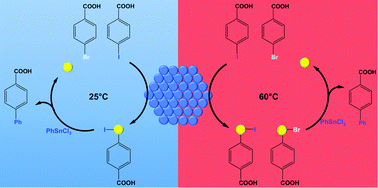Exploring the mechanism of Stille C–C coupling viapeptide-capped Pd nanoparticles results in low temperature reagent selectivity
Abstract
Herein we systematically probed the atom-leaching mechanism of Pd

* Corresponding authors
a
Department of Chemistry, University of Miami, 1301 Memorial Drive, Coral Gables, Florida 33146, USA
E-mail:
knecht@miami.edu
Tel: +1 305 284-9351
Herein we systematically probed the atom-leaching mechanism of Pd

 Please wait while we load your content...
Something went wrong. Try again?
Please wait while we load your content...
Something went wrong. Try again?
D. B. Pacardo and M. R. Knecht, Catal. Sci. Technol., 2013, 3, 745 DOI: 10.1039/C2CY20636F
To request permission to reproduce material from this article, please go to the Copyright Clearance Center request page.
If you are an author contributing to an RSC publication, you do not need to request permission provided correct acknowledgement is given.
If you are the author of this article, you do not need to request permission to reproduce figures and diagrams provided correct acknowledgement is given. If you want to reproduce the whole article in a third-party publication (excluding your thesis/dissertation for which permission is not required) please go to the Copyright Clearance Center request page.
Read more about how to correctly acknowledge RSC content.
 Fetching data from CrossRef.
Fetching data from CrossRef.
This may take some time to load.
Loading related content
